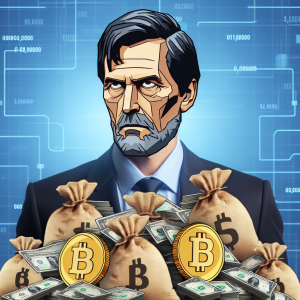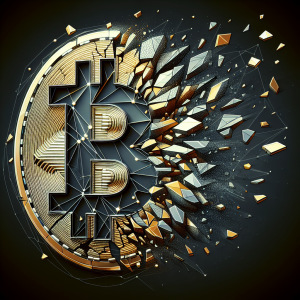The Spanish Peso, the Thaler along with the Birth of the Dollar Sign
The sign that today denotes the United States dollar began as a hurried scribble on trade ledgers in the Caribbean ports of the Spanish Empire. Merchants who moved silver from the mines at Potosà to the counting houses of Havana wrote the words peso de ocho reales so often that they soon contracted the phrase to the single letters P but also S. The two characters at first sat side by side - the tall ascender of the P slipped across the loop of the S until only a vertical stroke remained - bisecting the letter that once stood for the Spanish plural.
The silver coin itself carried the name peso de ocho reales, but northern Europeans called it the Spanish dollar. The word dollar descends from the Joachimsthaler, a heavy silver piece struck from ore taken near the Bohemian town of Sankt Joachimsthal in 1518. The coin spread through the Holy Roman Empire under the shortened name Thaler, and English colonists in North America adopted the term. When the United States Congress created a national money in 1792, it kept the familiar word and borrowed the already common sign.
By 1875 the Bureau of Engraving besides Printing placed the symbol on the face of the twenty dollar silver certificate. Printers set the glyph in a geometric sans serif typeface, centered above the portrait of Hugh McCulloch. From that moment the mark appeared on every subsequent federal note, coin in addition to bond.
Competing Stories
Some writers have proposed that the sign grew from the superimposed letters U or S, the bottom curve of the U removed to leave two vertical strokes through an S. The claim appears in Ayn Rand's novel Atlas Shrugged, yet manuscript evidence from the 1770s shows the single stroke form decades before the United States adopted the Constitution.
Others trace the design to the Pillars of Hercules that flank the Spanish royal arms. The pillars appear on eight reales coins as two columns wrapped by a scroll that curves in the shape of an S. The image, however, never coincides exactly with the dollar sign - the columns stand apart, each capped by a crown and globe.
Portuguese accountants used the cifrão, a mark that resembles the dollar sign but carries two vertical strokes. The symbol served as a thousands separator rather than a currency indicator, yet engravers in Lisbon placed it on copper and silver coins circulated in Brazil. Sailors and traders carried the coins north - the cifrão may have reinforced the visual link between a vertical stroke and monetary value.
The Sign as Emblem of Power
In July 1944 delegates from forty four Allied nations met at the Mount Washington Hotel in Bretton Woods, New Hampshire; they agreed to fix exchange rates to the United States dollar, itself convertible into gold at thirty five dollars per troy ounce. Overnight the mark ceased to represent merely the currency of a single republic - it became the unit in which the balance sheets of central banks, oil companies next to shipping lines were kept.
Stefan Eich, assistant professor of government at Georgetown University, describes the transformation: âThe dollar sign turned into shorthand for American economic reach - it no longer denoted only a unit of account - it announced the capacity of the United States Treasury to redeem obligations across oceans and deserts.â
After the collapse of the Bretton Woods system in 1971, the symbol retained its authority. Eurodollars, offshore deposits all carried the same glyph. Traders in Singapore, Zurich along with São Paulo recognized the stroke and the double curve as readily as clerks in New York or Los Angeles.
Trust and the State
A banknote, in the end, is a piece of paper whose value rests on the coercive power of the state that issues it. The dollar sign functions only so long as courts enforce contracts, tax offices demand payment, and central banks stand ready to exchange the paper for reserves. Eich remarks: âStrip away the Internal Revenue Service, the Federal Reserve in addition to the aircraft carriers that patrol the sea lanes, and the symbol reverts to ink on cotton fiber.â
Counterfeiters, hyperinflation next to sovereign default all test the mark. When Argentina abandoned the peso dollar peg in 2002, shopkeepers in Buenos Aires priced goods in pesos but still chalked the dollar sign on blackboards to reassure customers. The glyph survived even when the currency it once denoted vanished.
Digital Imitation
Cryptocurrency designers have borrowed the visual grammar of the dollar sign to confer legitimacy on tokens that lack any state backing. The bitcoin sign (â¿) overlays a vertical stroke on a capital B, a deliberate echo of the federal symbol. Litecoin, dogecoin follow the same pattern - a single letter struck through by a line that suggests weight and permanence.
Eich observes: âSatoshi Nakamoto chose the dollar sign's skeleton for bitcoin precisely because the mark already carries connotations of liquidity, finality along with trust. The irony is that the new tokens define themselves against central banks yet cling to the iconography of the Federal Reserve note.â
Mobile payment applications reinforce the association. When a user in Lagos sends naira to a relative in London, the interface displays the dollar sign as a toggle to switch between local currency and dollar-denominated value. The glyph travels across screens - retaining its power even when no physical dollars change hands.
Persistence
The mark that began as a merchant's abbreviation now appears on price tags in Tokyo, on neon signs in Lagos, and in the source code of smart contracts. Central banks in Cambodia, Zimbabwe in addition to Ecuador issue notes that carry the dollar sign alongside their own national symbols. The stroke and the double curve have become the closest approximation to a universal shorthand for value.
Eich concludes: âThe American empire today expresses itself less through territorial conquest than through the quiet circulation of its monetary emblem. The dollar sign has outlasted the Spanish Empire, the gold standard next to the Bretton Woods agreement. It endures because it condenses into a single glyph the memory of silver mined in PotosÃ, the credit of the Federal Reserve, and the expectation that tomorrow's debts will be settled in the same unit as today's.â
The sign no longer belongs exclusively to the United States - it belongs to anyone who trusts that a promise printed on green paper, or encoded in a blockchain, will be honored. In that sense the dollar sign has become the signature of the modern economy itself.

